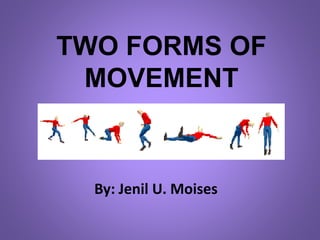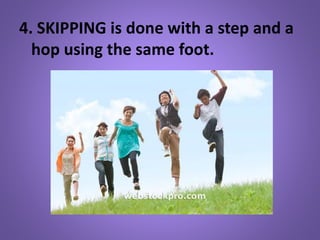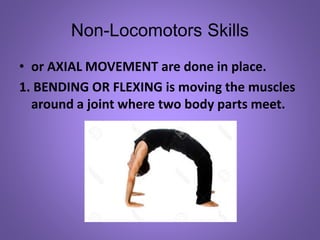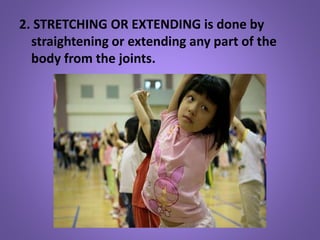Locomotor and Non-Locomotor Movements
- 1. TWO FORMS OF MOVEMENT By: Jenil U. Moises
- 2. LOCOMOTOR MOVEMENTS • This are done by moving the body from one place to another. 1. WALKING is shifting one’s weight from one foot to the other.
- 3. 2. RUNNING is moving with longer strides and in faster speed than walking
- 4. 3. HOPPING is springing on one foot and landing on the same foot.
- 5. 4. SKIPPING is done with a step and a hop using the same foot.
- 6. 5. JUMPING is springing on one foot or both feet and landing on both feet. (on landing always bend knees slightly.)
- 7. 6. LEAPING is springing on one foot and landing on the other foot (wide stride).
- 8. 7. SLIDING is done by gliding on the floor, sideward or forward using the right and left foot alternately.
- 9. 8. GALLOPING is stepping on one foot and cutting the other, either sideward or forward.
- 10. Non-Locomotors Skills • or AXIAL MOVEMENT are done in place. 1. BENDING OR FLEXING is moving the muscles around a joint where two body parts meet.
- 11. 2. STRETCHING OR EXTENDING is done by straightening or extending any part of the body from the joints.
- 12. 3. LIFTING OR RAISING is elevating a part of the body, usually for the arms and legs.
- 13. 4. TWISTING is moving a part of the body around a long axis, usually for the head and body.
- 14. 5. ROTATING OR ENCIRCLING is done by moving a part of the body around axis.
- 15. 6. SWINGING is a pendular movement below an axis.
- 16. 7. SWAYING is a pendular movement above an axis.
















